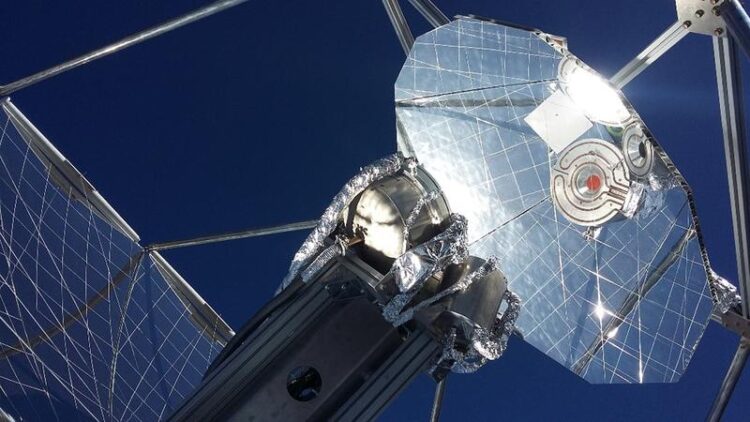3D printed reactor core makes solar fuel production more efficient

The sun-tracking parabolic reflector delivers concentrated sunlight to a solar reactor (seen via the secondary reflector) which converts water and CO2 extracted from the air into a syngas mixture, which in turn is further processed into drop-in fuels such as kerosene.
Credit: ETH Zurich / Alessandro Della Bella
In recent years, engineers at ETH Zurich have developed the technology to produce liquid fuels from sunlight and air.
In 2019, they demonstrated the entire thermochemical process chain under real conditions for the first time, in the middle of Zurich, on the roof of ETH Machine Laboratory. These synthetic solar fuels are carbon neutral because they release only as much CO2 during their combustion as was drawn from the air for their production. Two ETH spin-offs, Climeworks and Synhelion, are further developing and commercialising the technologies.
At the heart of the production process is a solar reactor that is exposed to concentrated sunlight delivered by a parabolic mirror and reaches temperatures of up to 1500 degrees Celsius. Inside this reactor, which contains a porous ceramic structure made of cerium oxide, a thermochemical cycle takes place for splitting water and CO2 captured previously from the air. The product is syngas: a mixture of hydrogen and carbon monoxide, which can be further processed into liquid hydrocarbon fuels such as kerosene (jet fuel) for powering aviation.
Until now, structures with isotropic porosity have been applied, but these have the drawback that they exponentially attenuate the incident solar radiation as it travels into the reactor. This results in lower inner temperatures, limiting the fuel yield of the solar reactor.
Now, researchers from the group of André Studart, ETH Professor of Complex Materials, and the group of Aldo Steinfeld, ETH Professor of Renewable Energy Carriers, have developed a novel 3D printing methodology that enables them to manufacture porous ceramic structures with complex pore geometries to transport solar radiation more efficiently into the reactor’s interior. The research project is funded by the Swiss Federal Office of Energy.
Hierarchically ordered designs with channels and pores that are open at the surface exposed to the sunlight and become narrower towards the rear of the reactor have proven to be particularly efficient. This arrangement enables to absorb the incident concentrated solar radiation over the entire volume. This in turn ensures that the whole porous structure reaches the reaction temperature of 1500°C, boosting the fuel generation. These ceramic structures were manufactured using an extrusion-based 3D printing process and a new type of ink with optimal characteristics developed specifically for this purpose, namely: low viscosity and a high concentration of ceria particles to maximise the amount of redox active material.
Successful initial testing
The researchers investigated the complex interplay between the transfer of radiant heat and the thermochemical reaction. They were able to show that their new hierarchical structures can produce twice as much fuel as the uniform structures when subjected to the same concentrated solar radiation of intensity equivalent to 1000 suns.
The technology for 3D printing the ceramic structures is already patented, and Synhelion has acquired the license from ETH Zurich. “This technology has the potential to boost the solar reactor’s energy efficiency and thus to significantly improve the economic viability of sustainable aviation fuels,” Steinfeld says.
Journal: Advanced Materials Interfaces
DOI: 10.1002/admi.202300452
Article Title: Solar-driven redox splitting of CO2 using 3D-printed hierarchically channelled ceria structures
Article Publication Date: 11-Aug-2023
Media Contact
All latest news from the category: Power and Electrical Engineering
This topic covers issues related to energy generation, conversion, transportation and consumption and how the industry is addressing the challenge of energy efficiency in general.
innovations-report provides in-depth and informative reports and articles on subjects ranging from wind energy, fuel cell technology, solar energy, geothermal energy, petroleum, gas, nuclear engineering, alternative energy and energy efficiency to fusion, hydrogen and superconductor technologies.
Newest articles

Innovative 3D printed scaffolds offer new hope for bone healing
Researchers at the Institute for Bioengineering of Catalonia have developed novel 3D printed PLA-CaP scaffolds that promote blood vessel formation, ensuring better healing and regeneration of bone tissue. Bone is…

The surprising role of gut infection in Alzheimer’s disease
ASU- and Banner Alzheimer’s Institute-led study implicates link between a common virus and the disease, which travels from the gut to the brain and may be a target for antiviral…

Molecular gardening: New enzymes discovered for protein modification pruning
How deubiquitinases USP53 and USP54 cleave long polyubiquitin chains and how the former is linked to liver disease in children. Deubiquitinases (DUBs) are enzymes used by cells to trim protein…



